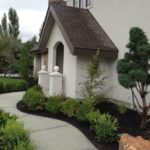Creating a Winter Friendly Habitat in Your Own Boise Landscape
When caring and selecting plants for your lawn care in Boise, keep in mind species that will benefit and protect the wildlife that shares our environment. Choosing species that provide food and shelter is especially needed in winter months for our outdoor creatures’ survival. Here are some tips and recommendations to help your landscape become a more “Winter Friendly Habitat.”
Winter is the perfect season for pruning deciduous trees and shrubs. Deciduous plants are woody plants that lose their leaves when they are dormant (asleep) for the winter.
● Fruit, flowering and shade trees should have crossing or rubbing branches removed. Dead branches should also be removed and trimming for shape can be done at this time because you have a better view of the branching pattern when the leaves are removed.
● Maintain straight central leaders on trees by removing narrow forks and keeping desired 90-degree lateral branches. This piece of lawn maintenance will pay big dividends come spring.
● Remember to prune outside the collar ¼” (where the branch connects to the trunk) to ensure damage is not done to the main tree trunk.
For spring flowering shrubs, such as Lilac, Forsythia, Hydrangea and Flowering Quince, pruning should not be done in winter.
● The reason is because next year’s spring flowers have already set new spring buds on old wood (last year’s growth). Rule of thumb: Once flowering shrubs have quit blooming, there is a six-week window you have to remove old blooms, prune & shape before the plant sets buds for the next season of blooming.
Summer blooming shrubs such as Russian Sage, Blue Mist Spirea and Butterfly Bush should be left untrimmed over the winter.
● Russian Sage should be severely pruned each year in mid spring to 12-15” tall. This lawn maintenance method and timing allows Russian Sage continue to bloom profusely each season.
● Blue Mist Spirea and Butterfly Bush should be cut back ⅓ to ½ high every third year, not annually. This rejuvenates the shrub and encourages blooming.
Our lawn service in Boise recommends that ornamental grasses can be cut back in fall/winter or can be left standing over winter. If left standing, ornamental grasses will provide winter interest with dried foliage and seed heads; especially as the low angled winter sunlight highlights their beauty.
● Waiting until mid-spring to cut back grasses provides many beneficial insects protection for overwintering eggs, larvae and adults. By waiting, eggs can hatch into larvae and finally adults. Beneficial insects are so important to a healthy environment, providing pollination and natural control over undesirable insects. Who knew keeping your ornamental grasses standing during the fall/winter to mid-spring had such an important contribution to the winter landscape in addition to pure beauty?
● Birds also use standing grasses for winter shelter and a source for seeds.
● Little Bluestem, Big Bluestem and Blue Grama (warm season grasses) should be cut back in the spring.
● Fescue and Feather Reed Grass (cool season grasses) have evergreen foliage and should not be cut completely to the ground. Instead shake out the grass blades with gloved hands and trim out any dead tips. In early spring, trim off old seed heads down into the foliage to allow for late spring blooms.
● If an ornamental grass has developed a dead center, it’s time to dig it up and divide the grass. Rule of Thumb: Digging up and dividing grasses should be done every three to five years to stimulate healthy new growth.
Perennials should be left standing, as they also provide the same shelter to beneficial insects and winter birds as the Ornamental grasses.
● Yarrow, Sedum and Coneflower along with other perennial species have seed heads when dried provide winter beauty.
● Perennials, such as Salvia and Hummingbird Mint, push the window of their cold hardiness and need the leaves and stems to serve as a protective mulch.
● Leaving perennials standing, especially young plants, will protect them until they are established. Waiting until mid-spring to cut back perennials is preferred except when the plant shows summer/fall disease or is infested with damaging insects.
Leaves are often overlooked as a valuable resource for building soil profile and mulch.
● Leaves should be removed from your lawn and used for mulch under trees, shrubs and evergreens.
● Leaves can be shredded into smaller pieces to mulch perennial beds and vegetable gardens. If larger leaves are used and they get wet, problems can develop with fungus and rot.
● Incorporation into the soil or around the base of plants will add organic matter improving the soil profile.
Lawns should have one final mow in late October/November, weather dependent, leaving grass at about 4” high. Cutting the lawn too short will weaken it and leave the stems vulnerable to damage from cold and dry conditions.
Enjoy the advantages and beauty of creating and supporting a “Winter Friendly Habitat in your own Landscape!
Cindy Boian
Diamond Lawns
“I have been in the landscape and nursery field for forty years in some related capacity. I have earned a Landscape Horticulture Degree from Colorado State University. Previous to CSU, I attended Larimer County Vo-Tech in Fort Collins, Colorado where I graduated their yearlong horticulture program. My experience has spanned from nursery development and production to owning my own landscaping business, working as a florist to landscape maintenance and design. My expertise and love of the high plains and mountain plant material has been a passion of mine. Through my current position of landscape Operations & Sales Manager at Diamond Lawns, I am so fortunate to educate and help to create beautiful sanctuaries for clients.”










